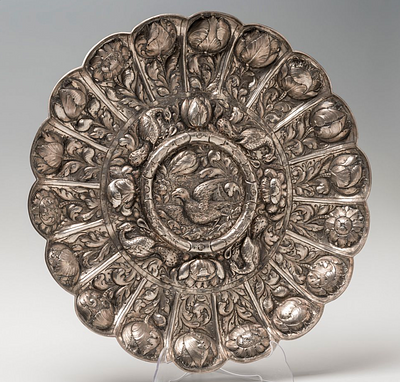Spanish school of the XVIII century. "Immaculate".
Lot 103
About Seller
Setdart Auction House
Carrer Aragó 346
Barcelona
Spain
Setdart Subastas was born in 2004 and is currently the first online art auction in Spain with solidity, prestige and reliability guaranteed by our more than 60,000 users. Setdart has a young, dynamic and enterprising team ready to successfully manage the purchase and sale of art works through custom...Read more
Categories
Estimate:
EUR€800 - EUR€1,000
$860.22 - $1,075.27
Absentee vs Live bid
Two ways to bid:
- Leave a max absentee bid and the platform will bid on your behalf up to your maximum bid during the live auction.
- Bid live during the auction and your bids will be submitted real-time to the auctioneer.
Bid Increments
| Price | Bid Increment |
|---|---|
| EUR€0 | EUR€10 |
| EUR€200 | EUR€25 |
| EUR€500 | EUR€50 |
| EUR€1,000 | EUR€100 |
| EUR€3,000 | EUR€200 |
| EUR€5,000 | EUR€500 |
| EUR€10,000 | EUR€1,000 |
| EUR€20,000 | EUR€2,000 |
| EUR€50,000 | EUR€5,000 |
About Auction
By Setdart Auction House
Jul 13, 2021
Set Reminder
2021-07-13 07:00:00
2021-07-13 07:00:00
America/New_York
Bidsquare
Bidsquare : DECORATIVE ARTS XV-XIX
https://www.bidsquare.com/auctions/setdart-auction-house/decorative-arts-xv-xix-7201
Setdart Auction House sofia@setdart.com
Setdart Auction House sofia@setdart.com
- Lot Description
Spanish school of the XVIII century. "Immaculate". Polychrome wood carving. Measurements: 100 cm (total height with base). Dated in the 18th century, the great Immaculate that concerns us is determined by the voluptuousness and the movement of her mantle, as well as by the ostentatious golden crown that decorates her head, worked by means of halos of light that radiate from its center. The virgin is represented full-length, on a pedestal formed by a serpent (in allusion to Satan) and with the moon at her feet. She appears with her hands joined in prayer at chest level and her face slightly tilted to one side. It is an image still anchored in the baroque, especially in the folds of the canvases, wide and very chiaroscuro, worked with a lot of relief. In addition, the sculptor has taken special care to reflect the expression of serene and mystical happiness of Mary's face, magnificently achieved. Medieval Christianity passionately debated the belief that Mary had been conceived without the stain of original sin. Some universities and corporations swore to defend this privilege of the Mother of God, several centuries before the First Vatican Council defined the dogma of faith in 1854. Spanish Baroque sculpture is one of the most authentic and personal examples of our art, because its conception and form of expression arose from the people and the deepest feelings that nestled in it. With the economy of the State broken, the nobility in decline and the high clergy burdened with heavy taxes, it was the monasteries, the parishes and the confraternities of clerics and laymen who promoted its development, the works sometimes being financed by popular subscription. Sculpture was thus compelled to embody the prevailing ideals in these environments, which were none other than religious ones, at a time when the counter-reformist doctrine demanded from art a realistic language so that the faithful would understand and identify with what was represented, and an expression endowed with an intense emotional content to increase the fervor and devotion of the people. The religious subject is, therefore, the preferred theme of Spanish sculpture of this period, which in the first decades of the century began with a priority interest in capturing the natural, to progressively intensify throughout the century the expression of expressive values, which is achieved through the movement and variety of gestures, the use of light resources and the representation of moods and feelings.
- Shipping Info
-
In-house shipping available. Please inquire at admin@setdart.com.
-
- Buyer's Premium



 EUR
EUR CAD
CAD AUD
AUD GBP
GBP MXN
MXN HKD
HKD CNY
CNY MYR
MYR SEK
SEK SGD
SGD CHF
CHF THB
THB
















